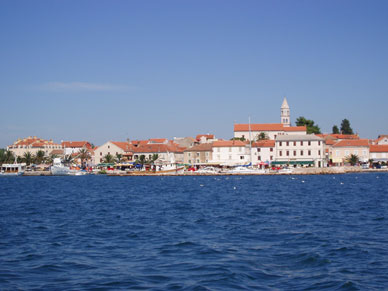
Once the crown city of Croatian kings, Biograd on sea is a well known tourist and nautical center as well as the center of the Riviera.
What Biograd an extraordinary destination for its natural surroundings, close to National Park Kornati, Krka National Park, and Vrana Lake Nature Park is known for fish farming and hunting of waterfowl.
The town, which grew ideal size for living man, lying on a peninsula surrounded by modern marinas and a promenade that offers spectacular view of the Pasman canal and the islands scattered in it.
Swimming in extremely clear water can be a few hundred meters away from the center of town where the gravel stretch of beach with many amenities in the shadow of ancient pine forests, and for those who prefer seclusion recommend wooded islands in the channel.
Location in the middle of the Croatian coast, surrounded by 5 National Parks and 2 Nature Parks, close to the Kornati Archipelago and Lake Vrana, a long tradition in tourism and a rich tourist, sports and restaurants are just some of the reasons for choosing Biograd as a destination for an interesting and dynamic vacation.
Powered by Google Translate
Biograd, city and port in northern Dalmatia, located 28 km south of Zadar. Located on a small peninsula and the mainland. On the northern side of the bay on the south Bošana Soline. In front of the Planac Islands and St. Katherine (the lighthouse). The average temperature in January is 7 ° C and in July 24.5 ° C, with average annual rainfall of 840 mm. The bay Soline there is a large public, sandy beach surrounded by pine trees. Biograd is a local commercial and transportation center, with good connections to its hinterland, surrounding coastal villages and towns and the island of Pasman. Throughout the city through the main Adriatic road and some 15 km north Benkovac a node on the highway Zagreb - Split. Biograd is a center of Riviera, which includes St. Petar na Moru, Turanj, Sveti Filip i Jakov, Biograd, Pakoštane and Drago, as well as several places on the island of Pasman: Tkon, Kraj, Pasman, Barotul, Mrljane, Neviđane, Dobropoljana, Banj and Ždrelac, and Vrgada on the island.
Powered by Google Translate
Biograd is a royal Croatian city first mentioned in mid-tenth century, while in November. century was the seat of Croatian kings and bishops.
The largest city flourished as the capital of the medieval Croatian rulers, and in 1102 it is crowned with the Croatian-Hungarian king Koloman. In 1202 Biograd is a refuge for fugitives from Zadar, and called Zara vecchia.
During the 13th and 14 century city manage ringtones dukes, Vrana Templars and Bribir ct. From 1409 to 1797. was under Venetian rule. He was killed in the Venetian-Turkish wars, and the 1521st and 1646th was destroyed and burned.
In the 16th and 17 century in Biograd is the center of Croatian national army, which had a major role in the anti war. Due to war destruction of its importance falls in order to strengthen again in the early 19th century, when during the French rule gets council and court.
Tourist Development Biograd began between the two world wars. The first guest, the Czechs began to come in Biograd during the 1920s. The first hotel built in 1935. on the site of the hotel Illyria. For the Serbian aggression (from 1991 to 1993.) City has suffered great devastation long-range artillery. City won a silver medal and the prestigious Silver Flower of Europe 2007th for landscaping and urban planning center.
Powered by Google Translate
Biograd is a relatively small town, but there is absolutely rich in history that reflect the Christian religious buildings, the parish church of Sv. Anastasia (1761), Romanesque church of Sv. Anthony (XIII century), St.. Roka (XVI century). From ancient buildings Biograd only the basilica of St.. John (XI century) survived the crash mletčko Biograd 1125th year, but because the nearby island of Pasman still stands 800 years old Benedictine Monastery of St.. Cosmas and Damian (1125 yr.) And the Franciscan Monastery of St.. Duje from XVI century
The core of the ancient settlement is located on a small peninsula. By the end of the 19th century, the city had walls with circular towers. The remains of the cathedral, a basilica with three towers, were destroyed, and the remains of the Monastery of St.. John, also a basilica with three towers, were found and preserved. Church of Sv. It has been preserved only in parts. Outside the ancient settlement, found the ruins of a small church near the vault in the early Croatian graves. The parish church of Sv. Anastasia, built in the 1761st with Baroque altars, one of which was of gilded wood.
Outside the ancient settlement is also the small church of Sv. And St. Roch. Antonio (1850). In the wider area there are prehistoric sites and remains of ancient aqueducts. The City Museum houses an archaeological collection with prehistoric, Roman and early Croatian findings, as well as cargo from the late 16th century.
Neighborhood of national parks on sea (Kornati Islands), mountain (the Velebit Paklenica), river (Niagara Falls) and Lakes (Plitvice), nature (Telascica on Long Island) and Lake Vrana rich freshwater fish, which inhabit the edges of waterfowl, and numerous islands and islets in the lovely Pasman canal Biograd guests the possibility of excursions to places that are among the most beautiful regions in Croatian. An interesting insight into the Croatian cultural heritage will provide you with the nearby historic towns of Zadar, Sibenik and Zadar.
Powered by Google Translate